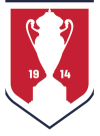The old cliche goes something like this: You have to be ready when your chance comes. No one, perhaps in the entire history of time, and certainly in the Modern Era of the U.S. Open Cup, was more ready for that chance when it came than third-string D.C. United goalkeeper Jordan Farr.
“I knew beforehand that I was going to come in if it was going to penalties, which made watching the game from the bench really, really interesting as far as the mountains and valleys of emotions go,” said the ever-smiling Farr, who was subbed in with approximately 180 seconds of OT to go in a topsy-turvy Round of 16 contest against Charlotte FC that was tangled at 3-3. “I got a legit warm-up, said a little prayer and tried to release all the potential nervousness.”
The job description was simple. See out the last few minutes and make some saves in the shootout. One save would be good, two would be great. But Farr, with a flair for the dramatic, decided to really sink his teeth into the role. “It’s the first time I ever felt pressure in a penalty shootout, because I’m being brought in specifically to help in that very low-percentage situation,” he explained. “Just try to dive the right way.”
He saved four of five spot-kicks. Four of Five. No goalkeeper, in the history of our tournament’s modern era, going back to 1995, has ever done such a thing. And those historic heroics were much-needed, as the game, which hemorrhaged goals in regular and extra-time (six in total, three for each team), turned very tense at shootout time with only three kicks hitting the net.
The Man for the Moment
“I’ve only ever seen something like that on TV, like in big, big games,” he said about coming into a game late-late with a specific, specialist’s brief to be the Shootout Hero. “I really don’t think I even grasped how big a moment it was and how rare a thing it is for everything to align the way it did.”
“Jordan has a really special ability in those moments – and he’s a special person,” said D.C. United coach Troy Lesesne, who, like Farr, has spent most of his career in the lower leagues of American soccer and didn’t hesitate to bring in his third-stringer who he calls “elite” in a shootout. “He embodies what we’re all about and, in a lot of ways, he’s the heartbeat of this club.”
It’s not hard work to like Jordan Farr. He’s gregarious and fun. There aren’t many MLS players who have the kind of self-effacing spirit to film a low-budget beef jerky advertisement in short-shorts, requiring them to dunk on an eight-foot basketball hoop while chomping down on mouthfuls of dehydrated beef.
The affections of Farr’s teammates, who mobbed their goalkeeper after his fourth save sent D.C. United to their first Quarterfinal since 2013, are the kind you just can’t fake.
“These guys, my teammates, they’re so supportive and they care about you as a whole person,” said Farr, still processing his contributions on that muggy night at Audi Field – not to mention his very new position in life, having traded small-pond bigness in the USL Championship for the endless – and often thankless – grind of a non-starter in MLS. “It’s such a unique situation for me, how I'm stepping into a new atmosphere in MLS and everything, suddenly, is different.”
At this point, it’s worth noting that Farr’s entry into the game, and his heroics in the shootout, were his first seconds as an MLS player. He’s no rookie, mind you. Far from it. He’s 31 years old and spent the last seven seasons in the Division II USL Championship, where he earned league Goalkeeper of the Year honors in 2022 and established himself, firmly, as among the top keepers in the lower leagues. Ask fans of Indy Eleven, San Antonio FC and the Tampa Bay Rowdies how they feel about Farr, and you’ll see eyes light up and smiles go wide for their former Number-One.
“Being a third-stringer is extremely difficult,” said Farr, who spends most of his time backing up Kim Joon Hong and Luis Barraza – who were hand-picked, along with Farr, by the club’s goalkeeper coach Cody Mizell at the start of this season. Farr’s daily grind as a squad player is a long way from the back flips and mob scenes that greeted his heroics in the Open Cup.
“It’s about humbling yourself and getting back to the grind and knowing that everything is really earning it,” said Farr, switching from the joys of the business to the heavier elements of his day-to-day professional life in D.C.. “It’s not easy on me, or my family. Doing that 180 flip from playing week in and week out to this, it’s been eye-opening as to what I’m really about mentality-wise.”
“Am I someone who says yes to a challenge?” he asked. “That’s what I want my daughters to see.”
Farr wanted to see just what “the next step” looked like. And he’s getting it up close, personal and right in the face. “The third-stringer never gets a day off,” Farr said with a shrug. “You're training Saturday and training Monday – if anyone’s out on the field, you’re out there too.
“You can control what you can control – that’s your training and the weight room,” he added, candidly, never one to pull punches. “And as far as things on the field go, I just have to wait for my moment.”
All Farr can do is wait, prepare and make the most of his chances if and when they come. So far, they’ve only come in the Open Cup – in a very specific way. And it’s fitting, somehow, given that the Open Cup is a competition he knows well and loves deeply.








